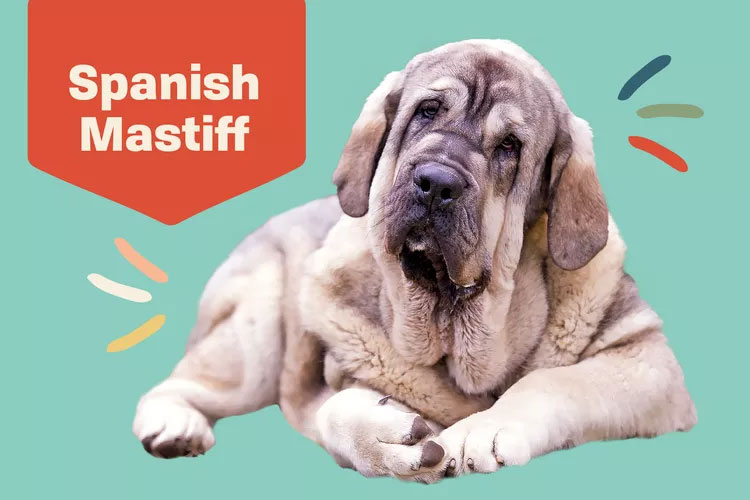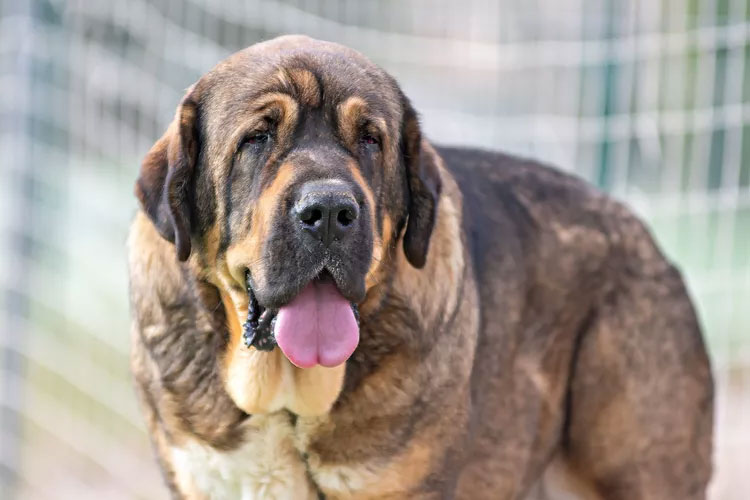
Spanish Mastiff Overview
| OFFICIAL NAME | Spanish Mastiff |
| COMMON NAME | Spanish Mastiff |
| PET HEIGHT | 28 to 35 inches |
| PET WEIGHT | 140 to 200 pounds |
| LIFESPAN | 10 to 12 years |
| GOOD WITH | families |
| TEMPERAMENT | aloof |
| INTELLIGENCE | high |
| SHEDDING AMOUNT | frequent |
| EXERCISE NEEDS | low |
| ENERGY LEVEL | calm |
| VOCAL LEVEL | when necessary |
| DROOL AMOUNT | high |
| BREED GROUP | none |
| BREED SIZE | extra large (101 lbs. or more) |
| COAT LENGTH | short |
| COLORS | black, fawn, gold / yellow, gray, red |
| PATTERNS | bicolor, brindle |
| OTHER TRAITS | good hiking companion, prone to health issues, strong loyalty tendencies |
"The Spanish mastiff is a dog who is loyal to his family and who [was bred to] protect his home without ever questioning his role," says Linda Simon, MVB, MRCVS, consulting veterinarian at FiveBarks. "They are calm dogs, taking most of life's day-to-day happenings in their stride."
An extremely rare breed in the United States, the Spanish mastiff is a dog that has been around for centuries. Today, these dogs don't have rigorous exercise or grooming routines, but because of their enormous size they're a good match for a home that has a large yard or (even better!) a rural home.
Appearance
The Spanish mastiff is a noble, giant dog with droopy jowls, extra skin, a stern yet wise expression, and a powerful gait. The Spanish mastiff size is extra-large, reaching heights up to 35 inches and weighing anywhere between 140–200 pounds.
Stocky and robust, he wears a dense, thick coat that's short and smooth. Spanish mastiff colors include yellow, fawn, red, black, as well as "wolf color" and "deer color," according to breed standards. The coat pattern is brindle or "parti-colored," which means the dog has a predominant color that's broken up by patches of one or more different colors.
The Spanish mastiff's coat requires a moderate amount of grooming. He needs to be brushed a couple of times a week and should get an occasional bath. He's also a regular shedder. "In areas where there is a seasonal change, Spanish Mastiffs will grow a thick undercoat that will tend to shed during warmer periods," says veterinarian Rasa Gentvilaitė-Žiemienė, the co-founder of Dogo, a dog training app.
With a large, triangular-shaped head that looks like a truncated pyramid, the Spanish mastiff has a broad, wet, black nose. His heavy, slack jowls mean his upper lip largely covers his lower one. He's also got huge, pointed canines that once helped him get a good grip on his prey. The Spanish mastiff's eyes are almond-shaped and typically hazel or dark in color, and his floppy, hanging ears are triangular in shape.
"Spanish mastiffs have a striking and imposing appearance," Gentvilaitė-Žiemienė says. "They would impress and even deter not only people who don't know their personality but also animals such as wolves."
Temperament
Spanish mastiff 101: This breed is a loyal dog to his family but is generally wary of strangers."While not fawningly affectionate, the Spanish mastiff will show love to [his] close family," Simon says. "However, they are more reserved than the average dog and can act aloof."

He's also aware of his enormous power and carries himself with dignity. He is intelligent, loving, and calm, says Gentvilaitė-Žiemienė. "They are loyal to their people but less social to interact with strangers or other dogs," she says.
When it comes to other household pets, Spanish mastiffs would prefer to be the king of the castle. They like to keep to themselves and require extensive socialization to live alongside other pets, Simon says. The Spanish mastiff would probably do best in a home with older children who know how to properly interact with pets, too.
Living Needs
Given their extra-large size, the Spanish mastiff is not an apartment dog, Simon says."They don't need extensive exercise, but they do need plenty of space and access to a yard," she says. "They appreciate being brought out on relaxing walks, exploring their neighborhood, and picking up on new scents."

This breed probably fits best in a rural environment and is a better hiking companion than jogging buddy, Gentvilaitė-Žiemienė says. And though he loves his favorite people, the Spanish mastiff tends to socialize little with strangers or other dogs—so he probably isn't pining to go to a dog park.
A calm household without young children or other animals would be the ideal fit for a Spanish mastiff, Gentvilaitė-Žiemienė says. Despite being somewhat aloof, these dogs do enjoy having their humans at home with them and need plenty of attention and love.
Care
Grooming wise, these dogs are relatively low maintenance thanks to their short coat. The Spanish Mastiff Club of Italy (SMCI) recommends brushing your dog twice a week and on a daily basis during shedding season.Owners should clean their dog's ears twice a month or so to prevent wax from building up, which can lead to infection. The Spanish mastiff's fast-growing nails require regular trimming, and a daily tooth-brushing routine will help keep your dog's breath fresh and prevent tartar build-up, tooth decay, and infections.

Spanish mastiffs enjoy spending most of the day lounging around the home, says Corinne Wigfall, DVM, BVS, BVM, and consulting veterinarian with SpiritDog Training. But when they're not patrolling the yard or taking a nap, they'll benefit from some exercise. They need about 30–45 minutes of physical activity every day, Wigfall says. But keep walks to the morning and evening during the summer, as Spanish mastiffs can suffer heat stroke because of their size and coat thickness, she says.
When it comes to training Spanish mastiff puppies (or changing old habits of more mature dogs), positive-reinforcement methods are the way to go. While these dogs are immensely intelligent, they aren't afraid to test boundaries, Wigfall says. Positive-reinforcement training sessions, with lots of head pats and treats on hand, done on a consistent basis will help these gentle giants become polite dogs.
Health
The Spanish mastiff lifespan is 10–12 years. Health-wise, these dogs are prone to many of the same conditions that other giant dogs face, Simon says.One of these includes bloat, a condition that can be fatal when it occurs in dogs. Bloat occurs when gas, food, or liquid becomes trapped in the dog's stomach and causes it to expand. But if the stomach twists over on itself it can cut off blood flow to vital organs, which is fatal without treatment. As a preventative measure in large dog breeds, a gastropexy procedure may be performed to prevent this from happening.
Spanish mastiffs are also prone to hip dysplasia and elbow dysplasia, she says. Spanish mastiff puppies may also be prone to panosteitis, which is a painful inflammation on the outer surface or shaft of one or more bones in a dog's legs. It's also known as "growing pains" and can affect rapidly growing dogs.

If you have a Spanish mastiff, be aware that this breed can also be prone to obesity, Wigfall says. Obesity in dogs can contribute to the development (or complicate the management) of other diseases, including kidney disease, cancer, diabetes mellitus, heart disease, and various respiratory diseases. Mixing veggies in with kibble and having a household agreement that nobody will sneak your dog extra treats are among some of the ways you can help your dog shed a few pounds.
History
The Spanish mastiff is an ancient dog that once was in charge of guarding livestock from wolves and other predators. The Spanish mastiff also assisted and protected the shepherds who moved sheep herds across Spain, according to the American Kennel Club.The role of mastiffs grew in the 10th century when Spain's economy was hinged on the production of wool. The dog's popularity continued to grow in the 12 century with the emergence of a new type of sheep (merinos), which usually spent the winter in the south of Spain and moved north to the mountain slopes come summer. The migrating herds of sheep were accompanied by shepherds and there was at least one mastiff for every 100 sheep.
Fun Facts
The Spanish Mastiff is featured in a painting called "Las Meninas" by the famous artist Diego Velázquez. The complex oil painting from 1656 is currently being displayed in Madrid's Prado Museum and depicts life in the court of King Philip IV of Spain.The Spanish mastiff's bark matches his appearance: It's deep, low-pitched, and can be heard from a long distance.
The Spanish mastiff is known as Mastín Español and Mastín de España in the dog's homeland of Spain.